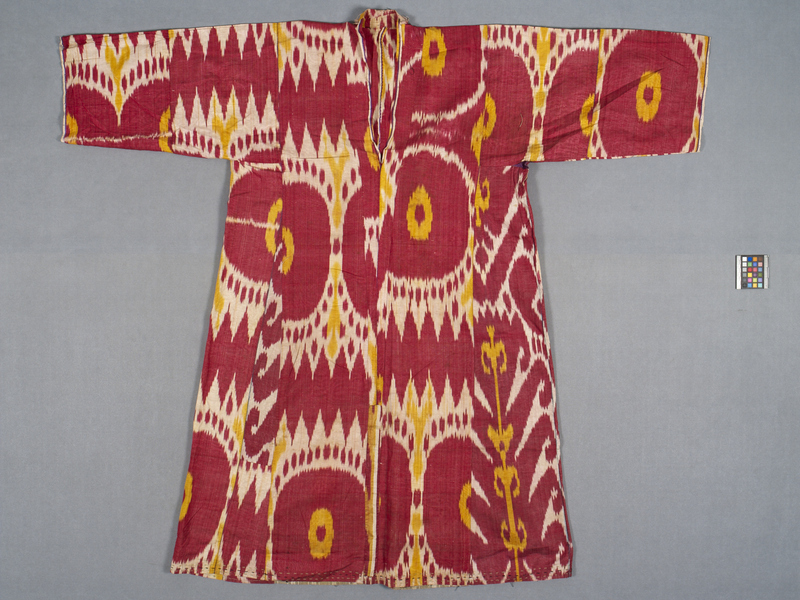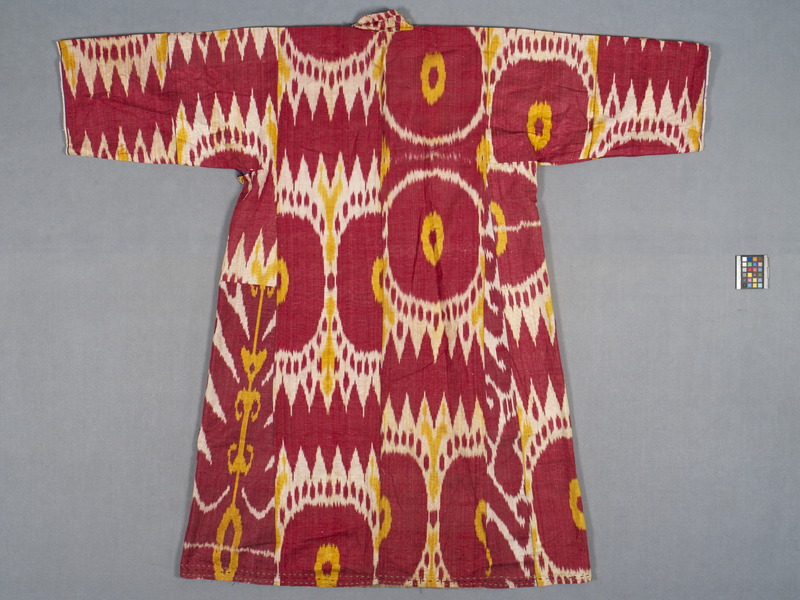Coat Item Number: 3231/18 from the MOA: University of British Columbia


Description
Man’s full-length, A-line, colourful, red, yellow and off-white ikat tunic or gown, with wide, straight sleeves and straight 36 cm slit at the centre front neck opening. A small stand-up collar has been roughly attached at the centre back. Warp ikat textile, with silk warp, cotton weft. Roughly made and irregularly patched together. Left underarm has been patched with a piece of dark purple cotton textile. Unlined. Hem is faced with strips of green and white plaid cotton textile. A blue stripe on the selvage shows through on some seams.
History Of Use
This type of garment would have been worn with wide trousers under ikat robes, and were worn by men, women and children of various cultures. The colourful printed cotton textiles which were typically used to line robes made in Central Asia were manufactured in Russia for the Central Asian market, as was the striped bias-cut cotton textile that was used as facings on all the edges (called the lapse). Following the Russian Revolution, the workshops that made ikat textiles like this one, which had been organized around family and social networks, were disbanded by the Soviet government, replaced by collective practices in factories. Eventually the making and wearing of ikat clothing disappeared.
Specific Techniques
Warp-ikat technique; shiny surface created with an egg glaze?
Narrative
Joanna Staniszkis purchased this garment and most others in the 3231 accession in Istanbul, shortly after the dissolution of the USSR; the robes had been previously stored in trunks for a considerable length of time.
Item History
- Made in Uzbekistan before 1900
- Collected in Istanbul, Turkey during 1991
- Owned by Joanna Staniszkis before March 20, 2017
- Received from Joanna Staniszkis (Donor) on March 20, 2017
What
- Name
- Coat
- Identification Number
- 3231/18
- Type of Item
- coat
- Material
- cotton fibre, silk fibre and dye
- Manufacturing Technique
- warp-ikat
- Overall
- height 140.0 cm, width 158.0 cm
Who
- Culture
- Uzbek
- Previous Owner
- Joanna Staniszkis
- Received from
- Joanna Staniszkis (Donor)
Where
- Holding Institution
- MOA: University of British Columbia
- Made in
- Uzbekistan
- Collected in
- Istanbul, Turkey
When
- Creation Date
- before 1900
- Collection Date
- during 1991
- Ownership Date
- before March 20, 2017
- Acquisition Date
- on March 20, 2017
Other
- Item Classes
- textiles
- Condition
- good
- Accession Number
- 3231/0018